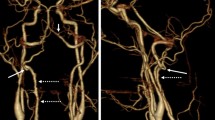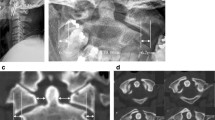Abstract
We report a case of lateral medullary syndrome (LMS) with extradural origin of the posterior inferior cerebellar artery (PICA). A 45-year-old construction worker presented with acute signs and symptoms of typical LMS. Prolonged work-related neck extension was reported just prior to the onset of symptoms. Cerebral angiography revealed a patent vertebrobasilar tree with an extradural origin of an otherwise normal appearing PICA ipsilaterally. Workup did not show evidence for cardioembolic or atheroembolic source. The presence of an extradural origin of PICA may be considered a predisposing factor for non-traumatic LMS associated with head and neck movement.


Similar content being viewed by others
Abbreviations
- LMS:
-
Lateral medullary syndrome
- PICA:
-
Posterior inferior cerebellar artery
- VA:
-
Vertebral artery
- TEE:
-
Transesohageal echocardiogram
- NIHSS:
-
National Institute of Health Stroke Scale
References
Ropper AH, Brown RH (2005) Adams and Victor’s principles of neurology, 8th edn. McGraw-Hill Professional, USA, pp 678–88
Kim JS (2003) Pure lateral medullary infarction: clinical-radiological correlation of 130 acute, consecutive patients. Brain 126(8):1864–1872
Frisoni G, Anzola G (1991) Vertebrobasilar ischemia after neck motion. Stroke 22(11):1452–1460
Sherman D, Hart R, Easton J (1981) Abrupt change in head position and cerebral infarction. Stroke 12(1):2–6
Weintraub MI, Khoury A (1995) Critical neck position as an independent risk factor for posterior circulation stroke. A magnetic resonance angiographic analysis. J Neuroimaging 5(1):16–22
Okawara S, Nibbelink D (1974) Vertebral artery occlusion following hyperextension and rotation of the head. Stroke 5(5):640–642
Sédat J, Dib M, Mahagne MH, Lonjon M, Paquis P (2002) Stroke after chiropractic manipulation as a result of extracranial postero-inferior cerebellar artery dissection. J Manip Physiol Ther 25(9):588–590
Fine AD, Cardoso A, Rhoton AL (1999) Microsurgical anatomy of the extracranial–extradural origin of the posterior inferior cerebellar artery. J Neurosurg 91(4):645–652
Kim JS, Lee JH, Choi CG (1998) Patterns of lateral medullary infarction: vascular lesion-magnetic resonance imaging correlation of 34 cases. Stroke 29(3):645–652
Conflict of interest
The author(s) declare that they have no competing interests.
Author information
Authors and Affiliations
Corresponding author
Rights and permissions
About this article
Cite this article
Razak, A., Clark, D., Farooq, M.U. et al. Wallenberg’s syndrome with extradural–extracranial origin of the posterior inferior cerebellar artery. Neurol Sci 32, 711–713 (2011). https://doi.org/10.1007/s10072-011-0609-1
Received:
Accepted:
Published:
Issue Date:
DOI: https://doi.org/10.1007/s10072-011-0609-1




